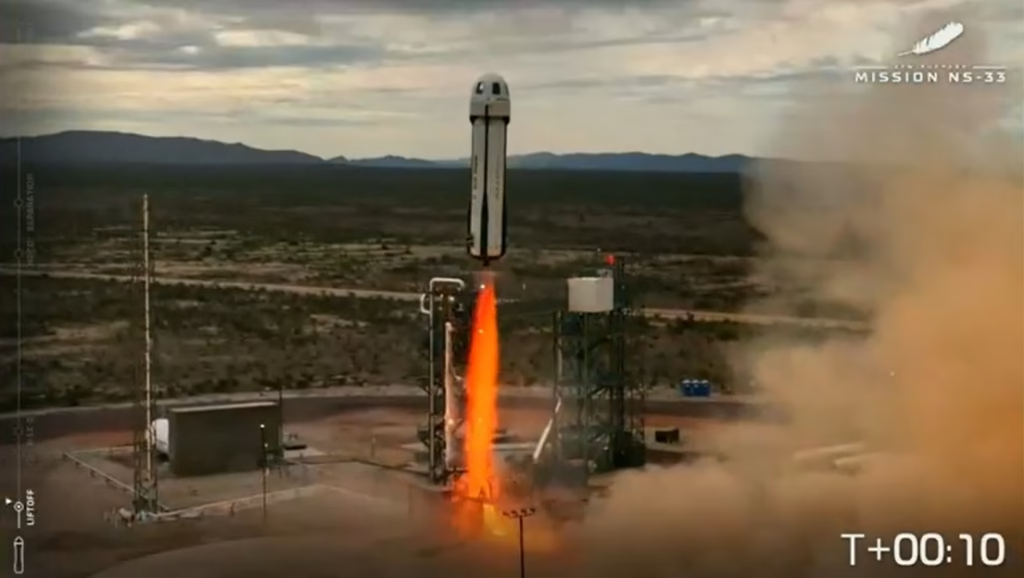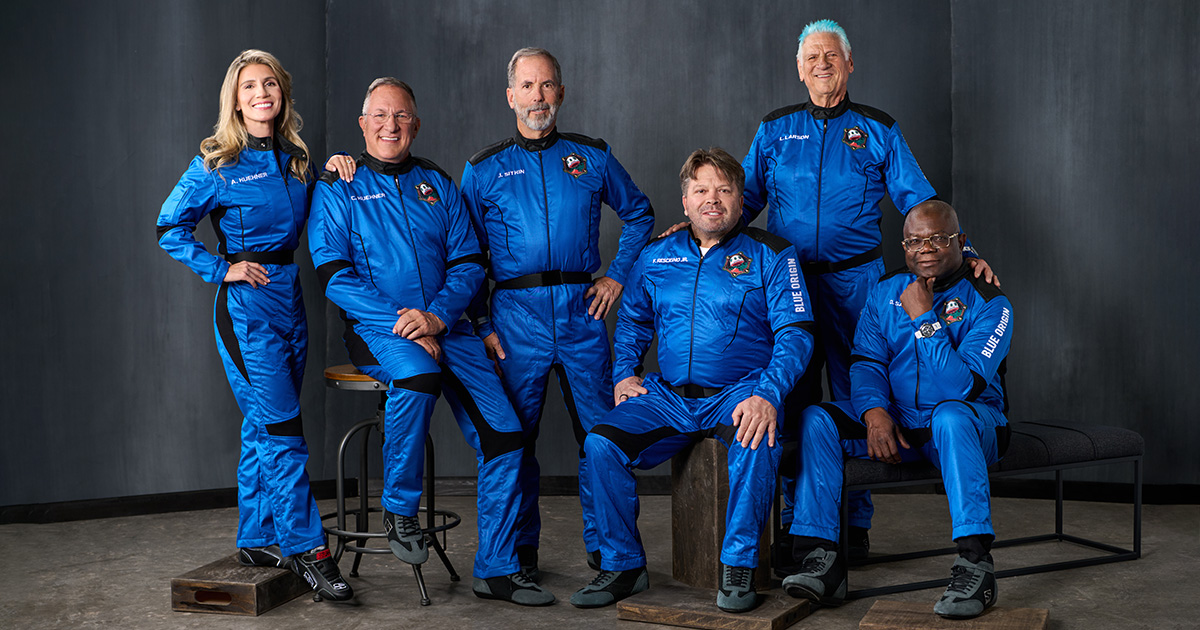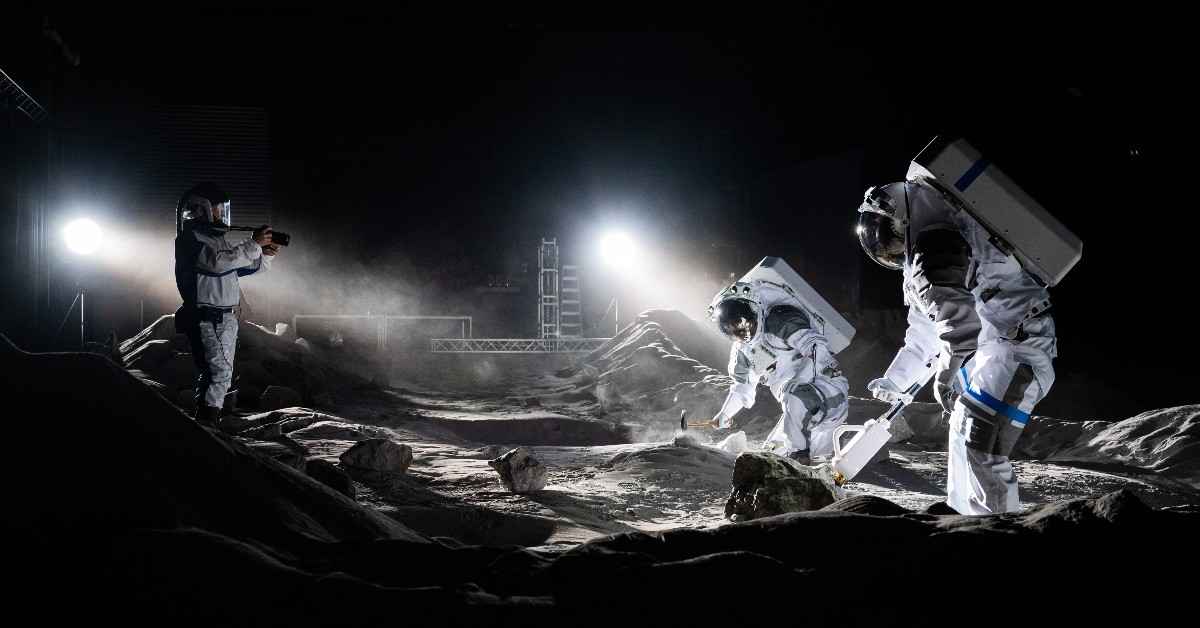Blue Origin’s New Shepard rocket successfully launched from West Texas, carrying six passengers and scientific payloads to the edge of space. Learn how this mission marks another step forward in reusable spaceflight and suborbital tourism.

Blue Origin’s New Shepard rocket successfully launched
On a calm Sunday morning, Blue Origin‘s New Shepard rocket roared to life and soared into the skies above the West Texas desert, marking another major milestone for the private space company founded by Jeff Bezos. The launch demonstrated both the reliability of the New Shepard system and Blue Origin’s continued ambition to pioneer the frontier of suborbital human spaceflight and scientific research.
This particular mission, dubbed NS-33, was closely watched by aerospace analysts, investors, and enthusiasts alike, as it followed a series of successful uncrewed and crewed missions since the vehicle’s first test flight in 2015. Sunday’s flight proved to be a technically flawless demonstration, reinforcing Blue Origin’s standing in the competitive landscape of commercial spaceflight.
Overview of the Blue Origin’s New Shepard rocket
Named after Alan Shepard, the first American astronaut to travel into space, the New Shepard is a fully reusable suborbital rocket designed for short, high-altitude missions. The system consists of two main components: a booster and a crew capsule. It is capable of carrying scientific payloads, commercial experiments, and human passengers to the edge of space—defined as the Kármán line at 100 kilometers (62 miles) above Earth.
Unlike orbital-class rockets like SpaceX’s Falcon 9 or Blue Origin’s upcoming New Glenn, New Shepard is specifically optimized for short-duration, high-altitude missions. Its ability to return both the booster and capsule safely to Earth allows Blue Origin to dramatically reduce launch costs, offering access to space in a reusable and sustainable manner.
Details of the Blue Origin’s New Shepard rocket Successful Launch
The NS-33 mission lifted off shortly after sunrise, benefiting from clear weather conditions at the West Texas launch facility near Van Horn. This flight carried six passengers into space, each experiencing a few minutes of weightlessness and panoramic views of Earth before safely returning to the surface.
The countdown proceeded smoothly, with no major delays reported. At T-minus zero, the rocket’s BE-3 engine ignited with a deep rumble, lifting the New Shepard off the ground and accelerating it through the desert sky. After approximately two and a half minutes, the booster shut down, and the capsule separated cleanly from the rocket.
Both components followed pre-programmed trajectories. The booster performed a controlled vertical landing back on the launch pad using precision thrusters and fins, while the capsule deployed parachutes to slow its descent and landed softly in the West Texas desert.
Blue Origin’s New Shepard rocket: Who Was Onboard?
Blue Origin’s NS-33 mission included six civilians, ranging from entrepreneurs to scientists and educators. Each of these participants underwent several days of pre-flight training, learning about emergency procedures, capsule operations, and microgravity orientation.
The mission emphasized Blue Origin’s goal of democratizing access to space. As with previous flights, the selection of passengers showcased a diverse range of backgrounds, including individuals selected through private bookings, corporate sponsorships, or Blue Origin’s nonprofit arm, Club for the Future.
By flying non-professional astronauts to the edge of space, Blue Origin continues to break barriers and inspire a new generation to consider space travel not just as a scientific endeavor, but as a real-life experience within reach.
Blue Origin’s New Shepard rocket: Science and Payloads
In addition to its human crew, the NS-25 mission carried several scientific payloads for academic institutions and commercial customers. These experiments utilized the brief microgravity period during the flight to gather data on materials science, fluid dynamics, biology, and physics.
Blue Origin offers researchers a unique platform to test instruments and prototypes in a space environment without the cost and complexity of orbital launches. The capsule is equipped with dedicated payload racks, sensors, and data collection tools to support a wide range of experiments.
Such missions also offer valuable validation opportunities for new technologies that may one day be used in orbit or on other planets. Microgravity exposure helps engineers understand how systems behave in space, allowing for refinement and future scaling.
Blue Origin’s New Shepard rocket: Reusability and Reliability
Perhaps one of the most striking achievements of Sunday’s mission was the continued validation of New Shepard’s reusability. Both the booster and capsule have now completed multiple flights, with minimal refurbishment required between missions.
This level of reuse stands in contrast to the traditional spaceflight paradigm, where rockets were treated as expendable. By proving that vehicles can be flown, recovered, and reused efficiently, Blue Origin is helping to bring down the cost of space access and establish a sustainable model for future space infrastructure.
The booster that flew Sunday’s mission had previously been used in earlier test flights, and its performance was consistent with all mission parameters. This ongoing reusability is critical for the economic feasibility of suborbital tourism and regular scientific launches.
Blue Origin’s New Shepard rocket: Environmental Considerations
As interest in space tourism grows, so too does public scrutiny over the environmental impact of rocket launches. Blue Origin emphasizes that the BE-3 engine used in the New Shepard rocket runs on liquid hydrogen and liquid oxygen, which produce water vapor as the primary exhaust product.
While no launch system is entirely free of environmental effects—particularly when factoring in production, transport, and ground operations—Blue Origin’s commitment to low-emission propulsion systems is a step toward sustainable space travel.
Furthermore, the company’s focus on reusability means fewer rockets need to be manufactured and discarded, reducing industrial waste and the need for raw materials.
The Future of Blue Origin’s New Shepard rocket
With the successful completion of NS-33, Blue Origin is looking ahead to an even busier schedule. The company aims to increase the frequency of New Shepard launches, offering more seats for space tourists and expanding access to microgravity research.
Long-term, Blue Origin has broader goals, including the development of orbital-class vehicles like the New Glenn rocket and the Blue Moon lunar lander. New Shepard serves as both a technological testbed and a proof-of-concept for the business model of space tourism.
By normalizing short-duration human spaceflight, the company hopes to pave the way for larger projects—such as space stations, lunar bases, and possibly even interplanetary travel.
Blue Origin’s New Shepard rocket: Comparison with Competitors
The commercial space industry is becoming increasingly crowded, with companies like Virgin Galactic, SpaceX, and Axiom Space all pursuing overlapping goals. Virgin Galactic, for instance, offers a similar suborbital experience using a spaceplane that launches from a carrier aircraft. Meanwhile, SpaceX continues to dominate orbital transport with its Falcon rockets and Crew Dragon capsule.
Each approach has its advantages, but Blue Origin’s emphasis on full vertical launches and reusable hardware sets it apart. New Shepard’s straightforward design and consistent performance make it one of the most reliable suborbital platforms currently in operation.
Furthermore, Blue Origin’s corporate structure—funded largely by Jeff Bezos himself—allows it to operate with a longer time horizon and more flexibility than publicly traded companies.
Public Perception and Impact
Public excitement around space travel has surged in recent years, driven in part by high-profile launches and celebrity passengers. Blue Origin has contributed significantly to this narrative, turning space travel from a distant dream into a tangible reality.
The impact of these missions extends beyond headlines. For many educators, students, and scientists, seeing civilians go to space helps inspire the next generation of innovators and dreamers. Blue Origin’s educational initiatives and outreach programs are designed to build upon this momentum and bring space closer to the classroom.
The passengers themselves often describe their flights as life-changing. The overview effect—the feeling of seeing Earth from space—leads many to return with a renewed sense of responsibility for the planet and its future.
Blue Origin’s New Shepard rocket: Conclusion
The successful NS-33 launch of Blue Origin’s New Shepard rocket marks another chapter in the evolution of human spaceflight. It is a demonstration not only of technical excellence but also of a larger vision: making space accessible, sustainable, and relevant to life on Earth.
As Blue Origin continues to innovate and expand, the space industry edges closer to a future where regular human travel beyond our atmosphere becomes routine. Sunday’s mission was more than just a flight—it was a bold reminder that space is no longer the domain of governments alone, but a new frontier open to all.
FAQs: Blue Origin’s New Shepard rocket
Q1. What is Blue Origin’s New Shepard rocket?
Blue Origin’s New Shepard rocket is a fully reusable suborbital rocket developed by Blue Origin to carry passengers and research payloads to the edge of space.
Q2. How high does New Shepard go?
It reaches altitudes above the Kármán line, typically around 100 kilometers (62 miles) above Earth’s surface.
Q3. How long is the flight?
Each mission lasts approximately 10 to 11 minutes from launch to landing.
Q4. Is New Shepard safe for humans?
Yes, the vehicle has completed numerous successful crewed and uncrewed missions, with rigorous safety protocols and escape systems.
Q5. Who can fly on New Shepard?
Tickets are open to civilians, researchers, and selected passengers through Blue Origin’s Club for the Future and commercial partnerships.
Q6. How is the rocket reused?
Both the booster and crew capsule are designed for reuse and can fly multiple missions with minimal refurbishment.
Q7. What engine does it use?
New Shepard uses a BE-3 liquid hydrogen and liquid oxygen engine, which produces only water vapor as exhaust.
Q8. Where is the launch site located?
Launches take place at Blue Origin’s private facility in West Texas, near the town of Van Horn.
Q9. How is this different from SpaceX or Virgin Galactic?
Unlike SpaceX’s orbital missions or Virgin Galactic’s air-launched spaceplane, New Shepard offers vertical suborbital flights using a reusable rocket and capsule system.
Q10. What’s next for Blue Origin?
The company plans to expand its suborbital operations, launch its New Glenn orbital rocket, and contribute to NASA’s Artemis program with its Blue Moon lunar lander.



